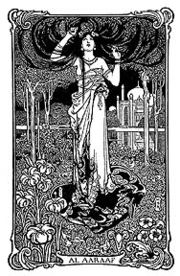
Nesace
Encyclopedia

Edgar Allan Poe
Edgar Allan Poe was an American author, poet, editor and literary critic, considered part of the American Romantic Movement. Best known for his tales of mystery and the macabre, Poe was one of the earliest American practitioners of the short story and is considered the inventor of the detective...
's early epic poem Al Aaraaf
Al Aaraaf
"Al Aaraaf" is an early poem by American writer Edgar Allan Poe, first published in 1829. It is based on stories from the Qur'an, and tells of the afterlife in a place called Al Aaraaf...
, which came out in 1829 in the poetry anthology Al Aaraaf, Tamerlane and Minor Poems. Together with Tamerlane
Tamerlane (poem)
"Tamerlane" is an epic poem by Edgar Allan Poe, first published in the 1827 collection Tamerlane and Other Poems. That collection, with only 50 copies printed, was not credited with the author's real name but by "A Bostonian." The poem's original version was 403 lines but trimmed down to 223 lines...
, Al Aaraaf is Poe's most extensive poem. It received mostly negative reviews for its complexity, obscure references, and odd structure.
Description
Nesace is the ruler of the "anchored realm" that is Al Aaraaf, a PurgatoryPurgatory
Purgatory is the condition or process of purification or temporary punishment in which, it is believed, the souls of those who die in a state of grace are made ready for Heaven...
of sorts set between Heaven
Heaven
Heaven, the Heavens or Seven Heavens, is a common religious cosmological or metaphysical term for the physical or transcendent place from which heavenly beings originate, are enthroned or inhabit...
and Hell
Hell
In many religious traditions, a hell is a place of suffering and punishment in the afterlife. Religions with a linear divine history often depict hells as endless. Religions with a cyclic history often depict a hell as an intermediary period between incarnations...
. She receives little to no description within the poem - she is said to have "angel limbs", a "gentle waist" and "golden hair". Common interpretation has her as being the embodiment of Beauty, a common theme in Poe's works.
Role in Al Aaraaf
After pacing around the gardens of Al Aaraaf, Nesace is contacted by GodGod
God is the English name given to a singular being in theistic and deistic religions who is either the sole deity in monotheism, or a single deity in polytheism....
in the first part of the poem and is asked to rally the inhabitants of the place so that they will be admitted in Heaven. The second part of the poem has Nesace rising the angel Ligeia, and through her rousing the many Seraphs
Seraph
A seraph is a type of celestial being in Judaism and Christianity...
and other angelical creatures that dwell in Al Aaraaf. Two of them - Angelo and Ianthe - fail to respond to Ligeia's calling, which results in their remaining in Al Aaraaf.

